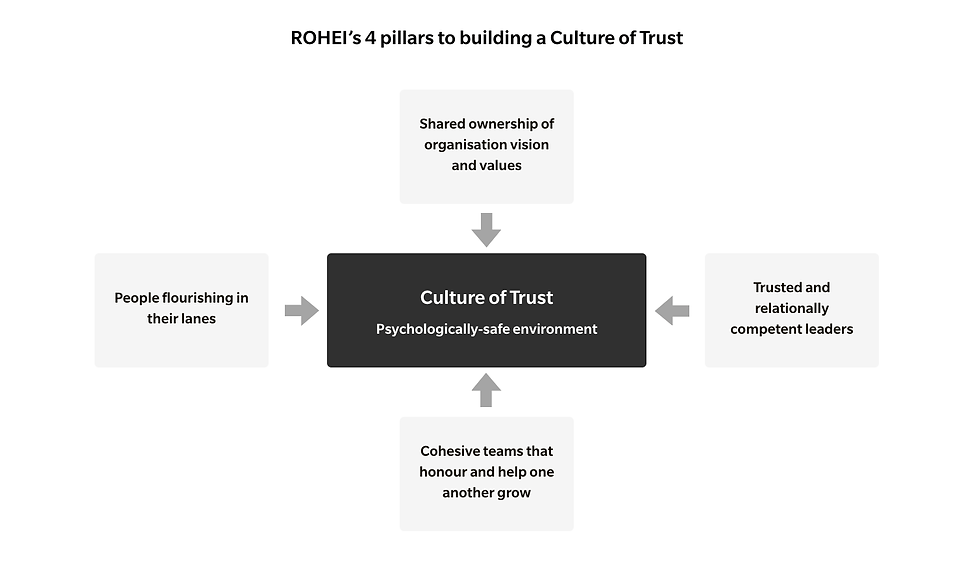Psychological Safety: A Must-Have in Times of Disruption
- ROHEI

- May 25, 2020
- 4 min read
An atmosphere of psychological safety is a key enabler of an innovative, high-performing team equipped to face threats such as disruption.
In a Nutshell
Psychological safety is not simply about being nice; it creates a climate in which speaking up is enabled
Psychological safety builds the foundation for innovative teams and prepares them to face threats and danger
Trust is the key to psychological safety
Signs of Unsafe Working Environments
Psychologically unsafe working environments leave tell-tale signs that leaders need to watch out for.
Are your meetings often too quiet? It could mean that team members are hesitant to share, for fear of judgment or ridicule. When a working environment is uncomfortable for the team to work in, it is a threat to your team’s ability to innovate and be prepared for disruption and change.
Becoming aware of these symptoms and uncovering blind spots will pave the way for addressing these problem areas and creating an atmosphere of psychological safety—a key enabler of an innovative, high-performing team.

Psychological Safety: What it Is and Isn’t
Psychological safety is not simply about being nice
It is not about perfect harmony and agreement within the team. “Psychological safety is about candor, about making it possible for productive disagreement and free exchange of ideas,” Quartz says in What Psychological Safety is Not.
Psychological safety enables speaking up
“Psychological safety describes a climate in which speaking up is enabled and expected. Such a climate is worth building when learning, knowledge sharing, error reporting or innovation are crucial for a company’s success,” says Amy Edmonson, the Harvard professor who first coined the term in 1999.
How Psychological Safety Creates a Foundation for Innovative Teams
Allowing risk-taking that is critical for agility and a future-ready mindset
How psychologically safe employees feel when they are at work has implications for team interactions, productivity, thinking out of the box, and ultimately, business success.
Safety empowers risk-taking. The absence of safety does the opposite. “When people don't feel safe, they're not inclined to take risks,” Forbes says in 14 Ways You Can Improve Psychological Safety at Work. “They may see opportunities to improve things or have differing ideas on how to approach a problem. But if the thought of stepping forward creates a sense of danger, most people are going to think twice. This means hindered development, both for the company and for the team members.”
Strengthening team performance
People give their best when they have the freedom to do so. “If mistakes are held against you, you then look to avoid making mistakes and so stop taking risks, rather than making the most out of your talents,” Fearless Organization says in their Introduction to Psychological Safety. Psychological safety strengthens team performance, innovation, learning, and personal success.
Empowering courageous, ethical actions
In The Infinite Game, author Simon Sinek identifies Ethical Fading as “a condition in a culture that allows people to act in unethical ways in order to advance their own interests, often at the expense of others, while falsely believing that they have not compromised their own moral principles. Ethical fading often starts with small, seemingly innocuous transgressions that, when left unchecked, continue to grow and compound.”
Psychological Safety protects the organisation from the dangers of Ethical Fading by creating an atmosphere in which the most beneficial thing for all parties would be to tell the truth and keep one another in check.

How Shell URSA’s Leadership Established Psychological Safety to Prepare the Team for the Most Dangerous Job in the World
Shell URSA, the biggest offshore deepwater drilling platform the company had ever built, was a high-risk operation that became a case study in safety records.
Simon Sinek sheds new light on this story in The Infinite Game and emphasises that behind the record-breaking physical safety ratings was the cultivation of psychological safety.
Creating a psychologically safe environment
In preparation for the highly dangerous mission, Rick Fox, the team head, arranged for the entire team to go through a workshop designed to allow them to shed their “tough-guy personas” and be open and honest.
Rick Fox knew they could not work together on a high-risk project without developing complete trust in one another.
“The members of Fox’s team got to know each other on a deeper level than ever before. Not just as coworkers but as humans. They opened up about who they were versus who they pretended to be.”
“Over the course of a year, Rick Fox, with (consultant) Claire Nuer’s guidance, built a team for the Shell URSA whose members felt psychologically safe with each other.” This means that on the job, they would not hesitate to ask for help when needed, or alert each other when something was amiss.
“What the URSA crew discovered is that the more psychologically safe they felt around each other, the better information flowed. For the first time in many of their careers, Fox’s crew felt safe to raise concerns. And the results were remarkable. The Shell URSA had one of the best safety records in the industry.”

Trust: the Key to Psychological Safety
To establish psychological safety in the workplace, trust needs to be a priority.
“If the SEALs, who are some of the highest-performing teams in the world, prioritize trust before performance, then why do we still think performance matters first in business?” Simon Sinek asks in The Infinite Game
The Four Pillars of Building a Culture of Trust and a Psychologically Safe Environment

To build a psychologically safe environment, lead with trust. Building a leadership team that values and prioritises trust is the foundation for an innovative and high-performing organisation.
